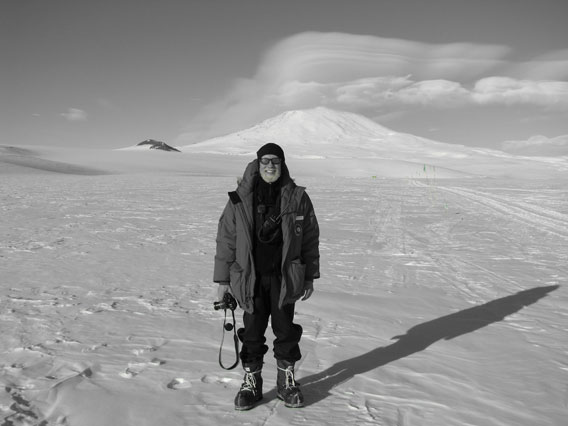A Martian Adventure in Antarctica
Traveling to the most desolate place on Earth to learn more about the Red Planet—and climate change
By Taylor McNeil
Spending weeks in a tent in rock-filled valleys that haven’t seen precipitation for several million years, where the temperatures are always far below freezing and 30-mile-per-hour winds blow constantly, might seem like a hardship assignment, but Sam Kounaves didn’t view it that way.
Click on the slide show to see photos from Sam Kounaves’ expedition to Antarctica.

To view the accompanying slideshow go to http://tuftsjournal.tufts.edu/2008/03/features/01/
He needed an environment as close as possible to that of Mars for a dry run of the scientific instruments that will be used to determine if the Red Planet could support—or ever has supported—life. Kounaves, a Tufts chemist, found that ideal location in several isolated dry valleys in Antarctica, and from mid-December to late January was happily ensconced there, along with five other researchers, who also worked to better understand the record of the Earth’s climate as written into the Antarctic soils. They dug into permafrost and used the soil to run tests with their equipment, even as the same instruments were winging their way to Mars on the Phoenix Mars Lander, due to touch down on May 25.
The Antarctic valleys are guarded from moisture by a strip of mountains that have blocked glaciers from entering it. “For the last 12 million years, these valleys have been pretty much the way they are now,” Kounaves says. “On average they receive less than four tenths of an inch of precipitation annually, in some places even less.” The researchers picked four particular valleys—Beacon, Taylor, Wright and Victoria—to study because they suspect the valleys represent a range of what Mars has been like over the past five million years.
Sometimes snow blows in from surrounding areas, but it never melts—except when heated by thirsty visiting scientists. At the height of summer, with temperatures peaking around minus 20 Celsius, the area is bereft of visible life. “It has the same look, same color as Mars,” says Kounaves. “If you look at pictures of Mars, that could be Beacon Valley, rocks etched out by millions of years of constant winds and fractured by extremes in temperatures.”
Kounaves pulls out black volcanic rocks he collected in Antarctica, oddly shaped and covered by small wave-like ripples. “The patterns are etched out by the wind—it looks like water. You pick up some of these rocks and realize they’ve probably been sitting there for 10 million years,” he says. “It’s amazing to be in these valleys. It’s the coldest, driest, windiest, place on Earth.”
The scientists spent their days and much of their nights working, easy to do given that the sun never sets at the height of the Antarctic summer. To obtain soil samples, they dug small pits, but it wasn’t simple. “It’s hard to dig—you have to chip away at it, scrape some of each layer off,” Kounaves says. He would put a cubic centimeter of the soil in their instrument, called the Web Chemistry Labs, add water at a 1-to-20 ratio and analyze it for the ions of salts such as calcium, magnesium, sodium and chloride, and properties like pH and oxidation potential. On Mars, Kounaves says, “the instrument will analyze the surface material to answer questions like does it have the chemistry to support life, in the past or even now? Could plants could grow in it? Is the soil on Mars like sulfuric acid and bleach? It’s something we need to know before any astronauts land there.”
In addition to preparing to analyze results from the Mars mission, which was launched last August, the researchers had another goal: contributing to the scientific understanding of the dry valleys in Antarctica and what they might say about climate change. In the test pits they dug, they looked for stratification layers that could be measured for age. “The effects of the climate basically write a pattern in the soil up and down over time,” Kounaves says. “We’re trying to understand the history as written in the record so we can understand the climate and use that information to extrapolate forward.” They took many samples, he says. “We shipped back about 12 giant containers frozen so we can do more studies on them.”
Extreme Science
When the six-person team first arrived in Antarctica, the National Science Foundation, which oversees the work of scientists it funds there, sent them off on a survival training mission. “They dumped us out on the middle of the Ross Ice Shelf; we were lucky that day—it was sunny,” Kounaves says. They were instructed how to quickly set up tents, build igloos and use propane heaters. After two days, having passed the test by staying alive and well, they were given the OK to head out to the more remote dry valleys.
Their first site was a 45-minute helicopter ride from McMurdo Station, the year-round base for American scientific operations in Antarctica. “I’d never camped out in this kind of weather,” says Kounaves. “I was very apprehensive at first, camping in a minus 25 degree Celsius area.” Not to mention the wind chill, which regularly brought the temperature down to minus 35 degrees. “Some nights I would fall asleep with my water bottle next to my sleeping bag, and it was frozen solid when I woke six hours later.”
Other than the constant wind, the thing that hit Kounaves the hardest was the total silence. When the wind died down, changing direction momentarily, “it becomes eerie,” he says.
The isolation was nearly complete. “You’re so used to seeing animals or even insects, but there are none,” he says. “Even in the desert, if you pick up enough rocks, you’d see some insects, once in a while a bird, but none of that exists here, and it hasn’t. It’s been this way since Antarctica developed the ice cap about 25 million years ago.”
The experience was invigorating, though. “It was amazing waking up in the morning and being so alert,” he says. “Your tent is minus 20, but you hop out of bed and get to it. Your body somehow seems to adjust to that. The adrenalin kicks in; every single morning there is easier than here. The air feels so pristine and crisp.”
When he returned to civilized world, so to speak, it was a somewhat difficult transition. For starters, Kounaves says, “when I came back here, I didn’t like having nighttime at first.”
His next stop is Tucson, Ariz. He’s decamping there in April to join colleagues as they prepare for Phoenix’s late May landing on Mars, having learned useful things about how their instruments will work in the extreme conditions and with real samples. But he wants to return to Antarctica as soon as possible. “We’re hoping to go back in the next couple of years, regardless of what Phoenix does, make some changes to our instruments and do a more detailed study of the record of the climate as it’s written in the soils in these valleys and hopefully compare it with the data we would have gotten back from Mars.”
For related stories, please see Tufts-made equipment will test Martian soil for signs of life and A decade of lab work hurtles toward Mars. For more information on the Mars mission, see Sam Kounaves’ website at http://planetary.chem.tufts.edu/Phoenix/index.html.
Taylor McNeil can be reached at taylor.mcneil@tufts.edu.


